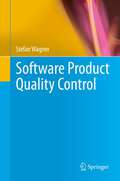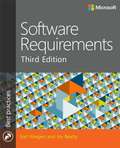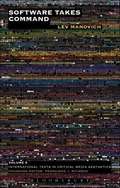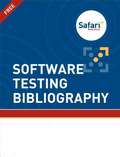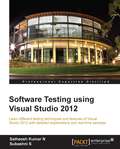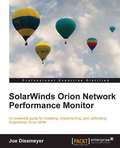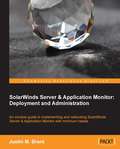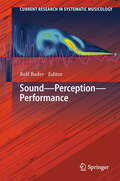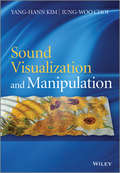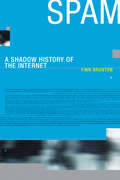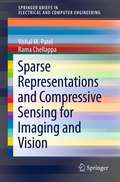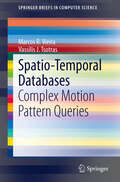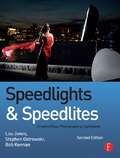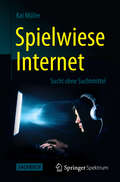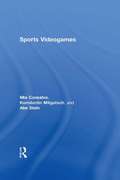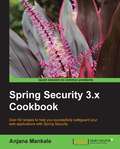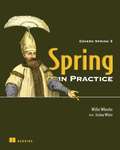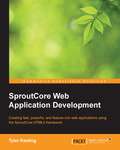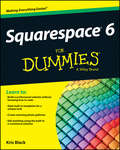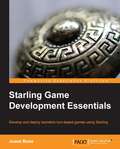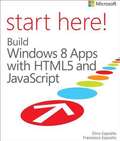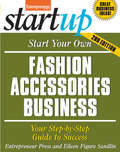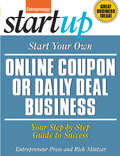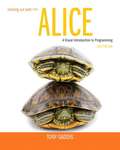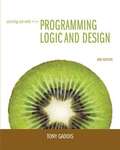- Table View
- List View
Software Product Quality Control
by Stefan WagnerQuality is not a fixed or universal property of software; it depends on the context and goals of its stakeholders. Hence, when you want to develop a high-quality software system, the first step must be a clear and precise specification of quality. Yet even if you get it right and complete, you can be sure that it will become invalid over time. So the only solution is continuous quality control: the steady and explicit evaluation of a product's properties with respect to its updated quality goals. This book guides you in setting up and running continuous quality control in your environment. Starting with a general introduction on the notion of quality, it elaborates what the differences between process and product quality are and provides definitions for quality-related terms often used without the required level of precision. On this basis, the work then discusses quality models as the foundation of quality control, explaining how to plan desired product qualities and how to ensure they are delivered throughout the entire lifecycle. Next it presents the main concepts and techniques of continuous quality control, discussing the quality control loop and its main techniques such as reviews or testing. In addition to sample scenarios in all chapters, the book is rounded out by a dedicated chapter highlighting several applications of different subsets of the presented quality control techniques in an industrial setting. The book is primarily intended for practitioners working in software engineering or quality assurance, who will benefit by learning how to improve their current processes, how to plan for quality, and how to apply state-of-the-art quality control techniques. Students and lecturers in computer science and specializing in software engineering will also profit from this book, which they can use in practice-oriented courses on software quality, software maintenance and quality assurance.
Software Requirements 3
by Karl E Wiegers Joy BeattyNow in its third edition, this classic guide to software requirements engineering has been fully updated with new topics, examples, and guidance. Two leaders in the requirements community have teamed up to deliver a contemporary set of practices covering the full range of requirements development and management activities on software projects. Describes practical, effective, field-tested techniques for managing the requirements engineering process from end to end. Provides examples demonstrating how requirements "good practices" can lead to fewer change requests, higher customer satisfaction, and lower development costs. Fully updated with contemporary examples and many new practices and techniques. Describes how to apply effective requirements practices to agile projects and numerous other special project situations. Targeted to business analysts, developers, project managers, and other software project stakeholders who have a general understanding of the software development process. Shares the insights gleaned from the authors' extensive experience delivering hundreds of software-requirements training courses, presentations, and webinars. New chapters are included on specifying data requirements, writing high-quality functional requirements, and requirements reuse. Considerable depth has been added on business requirements, elicitation techniques, and nonfunctional requirements. In addition, new chapters recommend effective requirements practices for various special project situations, including enhancement and replacement, packaged solutions, outsourced, business process automation, analytics and reporting, and embedded and other real-time systems projects.
Software Takes Command
by Lev ManovichSoftware has replaced a diverse array of physical, mechanical, and electronic technologies used before 21st century to create, store, distribute and interact with cultural artifacts. It has become our interface to the world, to others, to our memory and our imagination - a universal language through which the world speaks, and a universal engine on which the world runs. What electricity and combustion engine were to the early 20th century, software is to the early 21st century. Offering the the first theoretical and historical account of software for media authoring and its effects on the practice and the very concept of 'media,' the author of The Language of New Media (2001) develops his own theory for this rapidly-growing, always-changing field. What was the thinking and motivations of people who in the 1960 and 1970s created concepts and practical techniques that underlie contemporary media software such as Photoshop, Illustrator, Maya, Final Cut and After Effects? How do their interfaces and tools shape the visual aesthetics of contemporary media and design? What happens to the idea of a 'medium' after previously media-specific tools have been simulated and extended in software? Is it still meaningful to talk about different mediums at all? Lev Manovich answers these questions and supports his theoretical arguments by detailed analysis of key media applications such as Photoshop and After Effects, popular web services such as Google Earth, and the projects in motion graphics, interactive environments, graphic design and architecture. Software Takes Command is a must for all practicing designers and media artists and scholars concerned with contemporary media.
Software Testing Bibliography
by Safari Content TeamSoftware testing is for some developers an annoyance, for others the only way to work. Testing has a number of different roles in any development project. Ensuring that the software is working properly is the most obvious, but testing can also be used to check performance, search specifically for memory leaks and other bugs, handle environment testing, and to ensure that your software works within the operating system and with any other tools that your software uses or relies upon. If your software has a user interface element, then it also needs to be tested, and your entire stack needs to be confirmed and tested across all of the different environments and systems you expect to deploy them on. Ultimately, with any type of software testing, the aim is to make your software better and ensure that your software not only does what you designed it to, but also doesn't do anything you didn't expect. To that end, in this Safari Books Online bibliography, we have selected a range of different books that cover a wide range of testing techniques. We've included titles on fine-grained basic unit-based testing such as JUnit, language-specific testing for JavaScript, PHP, Perl, Scala, ASP and others. You will also find titles covering security and penetration testing, UI testing, including automation frameworks such as Selenium, and testing within specific environments, like Visual Studio.
Software Testing using Visual Studio 2012
by Subashni S Satheesh Kumar NWe will be setting up a sample test scenario, then we'll walk through the features available to deploy tests.This book is for developers and testers who want to get to grips with Visual Studio 2012 and Test Manager for all testing activities and managing tests and results in Team Foundation Server. It requires a minimal understanding of testing practices and the software development life cycle; also, some coding skills would help in customizing and updating the code generated from the web UI testing.
SolarWinds Orion Network Performance Monitor
by Joe DissmeyerThis book is written in a friendly manner written by an expert with numerous years of practical experience utilizing SolarWinds Orion NPM as a network monitoring solution.This book is for systems administrators, system analysts, and systems engineers who are tasked with installing and implementing a network performance monitor. Knowledge of basic network concepts is required.
SolarWinds Server & Application Monitor: Deployment and Administration
by Justin M. BrantA concise and practical guide to using SolarWinds Server & Application Monitor.If you are an IT professionals ranging from an entry-level technician to a more advanced network or system administrator who is new to network monitoring services and/or SolarWinds SAM, this book is ideal for you.
Sound - Perception - Performance
by Rolf BaderMusical Performance covers many aspects like Musical Acoustics, Music Psychology, or motor and prosodic actions. It deals with basic concepts of the origin or music and its evolution, ranges over neurocognitive foundations, and covers computational, technological, or simulation solutions. This volume gives an overview about current research in the foundation of musical performance studies on all these levels. Recent concepts of synchronized systems, evolutionary concepts, basic understanding of performance as Gestalt patterns, theories of chill as performance goals or historical aspects are covered. The neurocognitive basis of motor action in terms of music, musical syntax, as well as therapeutic aspects are discussed. State-of-the-art applications in performance realizations, like virtual room acoustics, virtual musicians, new concepts of real-time physical modeling using complex performance data as input or sensor and gesture studies with soft- and hardware solutions are presented. So although the field is still much larger, this volume presents current trends in terms of understanding, implementing, and perceiving performance.
Sound Visualization and Manipulation
by Yang-Hann Kim Jung-Woo ChoiUnique in addressing two different problems – sound visualization and manipulation – in a unified way Advances in signal processing technology are enabling ever more accurate visualization of existing sound fields and precisely defined sound field production. The idea of explaining both the problem of sound visualization and the problem of the manipulation of sound within one book supports this inter-related area of study. With rapid development of array technologies, it is possible to do much in terms of visualization and manipulation, among other technologies involved with the spatial distribution of sound. This book aims to explore various basic functions for the visualization and manipulation and demonstrate to the reader how these properties determine the quality of visualization and manipulation. The first half of the book introduces some basic and general concepts and theories and the second part of the book explains a number of techniques in sound visualization and manipulation. It offers a unified presentation to two very different topics - sound field visualization techniques based on microphone arrays, and techniques for generation of controlled sound fields using loudspeaker arrays. The authors emphasize the similarities between these two physical problems and between the mathematical methods used for solving them. With extensive examples throughout the book, chapters include: Acoustic Wave Equation and its Basic Physical Measures, Acoustic Wave Equation and its Basic Physical Measures, Basic Theory of Sound Visualization, Acoustic Holography, Beamforming, Basic Theory of Sound Manipulation, Sound Focusing, and Sound Field Reproduction. The first book to combine both the visualization and manipulation of sound technologies in one comprehensive volume Presents the basic concepts using simple one dimensional cases and then extends the concept to three dimensional cases, enabling easier understanding of the fundamental concepts through the use of minimum mathematics Provides a solid understanding of associated physics as well as mathematical concepts for understanding the technologies, addressing diffraction problems in an integrated format by using Kirchhoff-Helmholtz integral equation Uses extensive examples demonstrating the benefits and drawbacks of various applications, including beamforming and acoustic holography A valuable resource forpost/graduate students, acoustic engineers, audio and noise control system developers
Spam: A Shadow History of the Internet (Infrastructures)
by Finn BruntonWhat spam is, how it works, and how it has shaped online communities and the Internet itself.The vast majority of all email sent every day is spam, a variety of idiosyncratically spelled requests to provide account information, invitations to spend money on dubious products, and pleas to send cash overseas. Most of it is caught by filters before ever reaching an in-box. Where does it come from? As Finn Brunton explains in Spam, it is produced and shaped by many different populations around the world: programmers, con artists, bots and their botmasters, pharmaceutical merchants, marketers, identity thieves, crooked bankers and their victims, cops, lawyers, network security professionals, vigilantes, and hackers. Every time we go online, we participate in the system of spam, with choices, refusals, and purchases the consequences of which we may not understand.This is a book about what spam is, how it works, and what it means. Brunton provides a cultural history that stretches from pranks on early computer networks to the construction of a global criminal infrastructure. The history of spam, Brunton shows us, is a shadow history of the Internet itself, with spam emerging as the mirror image of the online communities it targets. Brunton traces spam through three epochs: the 1970s to 1995, and the early, noncommercial computer networks that became the Internet; 1995 to 2003, with the dot-com boom, the rise of spam's entrepreneurs, and the first efforts at regulating spam; and 2003 to the present, with the war of algorithms—spam versus anti-spam. Spam shows us how technologies, from email to search engines, are transformed by unintended consequences and adaptations, and how online communities develop and invent governance for themselves.
Sparse Representations and Compressive Sensing for Imaging and Vision
by Vishal M. Patel Rama ChellappaCompressed sensing or compressive sensing is a new concept in signal processing where one measures a small number of non-adaptive linear combinations of the signal. These measurements are usually much smaller than the number of samples that define the signal. From these small numbers of measurements, the signal is then reconstructed by non-linear procedure. Compressed sensing has recently emerged as a powerful tool for efficiently processing data in non-traditional ways. In this book, we highlight some of the key mathematical insights underlying sparse representation and compressed sensing and illustrate the role of these theories in classical vision, imaging and biometrics problems.
Spatio-Temporal Databases
by Marcos R. Vieira Vassilis J. TsotrasThis brief presents several new query processing techniques, called complex motion pattern queries, specifically designed for very large spatio-temporal databases of moving objects. The brief begins with the definition of flexible pattern queries, which are powerful because of the integration of variables and motion patterns. This is followed by a summary of the expressive power of patterns and flexibility of pattern queries. The brief then present the Spatio-Temporal Pattern System (STPS) and density-based pattern queries. STPS databases contain millions of records with information about mobile phone calls and are designed around cellular towers and places of interest. Density-based pattern queries capture the aggregate behavior of trajectories as groups. Several evaluation algorithms are presented for finding groups of trajectories that move together in space and time, i. e. within a predefined distance to each other. Finally, the brief describes a generic framework, called DivDB, for diversifying query results. Two new evaluation methods, as well as several existing ones, are described and tested in the proposed DivDB framework. The efficiency and effectiveness of all the proposed complex motion pattern queries are demonstrated through an extensive experimental evaluation using real and synthetic spatio-temporal databases. This clear evaluation of new query processing techniques makes Spatio-Temporal Database a valuable resource for professionals and researchers studying databases, data mining, and pattern recognition.
Speedlights & Speedlites: Creative Flash Photography at the Speed of Light
by Lou JonesCanon Speedlites and Nikon Speedlights are small, off-camera flashguns that can provide big results - if you know how to use them properly. Acclaimed Boston photographers Lou Jones, Bob Keenan and Steve Ostrowski guide you through the technical and creative aspects of how to get the most out of these powerful tools in this indispensable guide, packed full of inspirational images and comprehensive diagrams of the lighting set ups used to capture them. They are significantly more advanced, lighter and considerably cheaper than a standard flashgun, and have many advantages. They are small (and cheap) enough that a number can be carried in your kit, and they can be used in combination, triggered wirelessly. They use through-the-lens (TTL) metering, which allows you to use the in-camera LCD and histograms to calculate the required power/direction, rather than havng to use a light meter or trial and error. They use proprietary, dedicated technology (from Canon and Nikon) that means there are no compatability issues. Getting the most out of them, however, remains a mystery - most photographers still just use their speedlights in the same way as a standard flash gun. This is where this book comes in.
Spielwiese Internet: Sucht ohne Suchtmittel
by Kai MüllerInternetsucht ist eine moderne Form einer psychischen Problematik, die offensichtlich immer mehr Menschen etwas angeht, entweder direkt oder indirekt. Wie eine verschwommene Schimäre taucht dieses Schlagwort "Internetsucht" in den Medien auf. Zahlen von Betroffenen, Symptome und Auswirkungen dieses neuen Phänomens werden von unterschiedlichen Experten in unterschiedlicher Weise diskutiert und dennoch bleibt der Nicht-Fachmann nur allzu oft mit mehr Fragen als Antworten zurück. Dieses Buch soll dem Leser einen möglichst umfassenden Einblick vermitteln. Es vermittelt Antworten auf zentrale Fragen, wie z.B.: Was verbirgt sich hinter dem Begriff der Internetsucht? Wann ist ein Verhalten bereits Ausdruck einer Sucht? Welche Menschen sind als besonders gefährdet anzusehen? Welche Maßnahmen können ergriffen werden, um einer Internetsucht zu begegnen? Der aktuelle psychologische Kenntnisstand wurde hierzu nachvollziehbar aufbereitet und in einen engen praxisnahen Bezug gesetzt. Zielgruppen für dieses Werk sind alle, die sich über das Thema Spiel- und Internetsucht informieren möchten sowie alle, die selbst oder in ihrem familiären Umfeld oder Bekanntenkreis Menschen kennen, die davon betroffen sind. Nebenzielgruppe sind alle diejenigen, die im beruflichen Umfeld mit Betroffenen zu tun haben. Der Autor ist Diplompsychologe und arbeitet in der deutschlandweit einzigartigen Ambulanz für Spielsucht. Innerhalb seines beruflichen Umfeldes befasst er sich intensiv mit dem Thema der substanzungebundenen Abhängigkeitserkrankungen (Verhaltenssüchte), hier insbesondere mit der Internet- und Computerspielsucht sowie der Glücksspielsucht.
Sports Videogames
by Mia Consalvo Abe Stein Konstantin MitgutschFrom Pong to Madden NFL to Wii Fit, Sports Videogames argues for the multiple ways that sports videogames—alongside televised and physical sports—impact one another, and how players and viewers make sense of these multiple forms of play and information in their daily lives. Through case studies, ethnographic explorations, interviews and surveys, and by analyzing games, players, and the sports media industry, contributors from a wide variety of disciplines demonstrate the depth and complexity of games that were once considered simply sports simulations. Contributors also tackle key topics including the rise of online play and its implications for access to games, as well as how regulations surrounding player likenesses present challenges to the industry. Whether you’re a scholar or a gamer, Sports Videogames offers a grounded, theory-building approach to how millions make sense of videogames today.
Spring Security 3.x Cookbook
by Anjana MankaleThis book follows a cookbook style exploring various security solutions provided by Spring Security for various vulnerabilities and threat scenarios that web applications may be exposed to at the authentication and session level layers.This book is for all Spring-based application developers as well as Java web developers who wish to implement robust security mechanisms into web application development using Spring Security.Readers are assumed to have a working knowledge of Java web application development, a basic understanding of the Spring framework, and some knowledge of the fundamentals of the Spring Security framework architecture. Working knowledge of other web frameworks such as Grails and so on would be an added advantage to exploit the whole breadth of recipes provided in this book, but this is not mandatory.
Spring in Practice
by Joshua White Willie WheelerSummarySpring in Practice shows you how to tackle the challenges you face when you build Spring-based applications. The book empowers software developers to solve concrete business problems by mapping application-level issues to Spring-centric solutions. It diverges from other cookbooks because it presents the background you need to understand the domain in which a solution applies before it offers the specific steps to solve the problem. About this BookSpring in Practice covers 66 Spring development techniques and the practical issues you will encounter when using them. The book starts with three carefully crafted introductory chapters to get you up to speed on the fundamentals. And then, the core of the book takes you step-by-step through the important, practical techniques you will use no matter what type of application you're building. You'll hone your Spring skills with examples on user accounts, security, NoSQL data stores, and application integration. Along the way, you'll explore Spring-based approaches to domain-specific challenges like CRM, configuration management, and site reliability.What's InsideCovers Spring 3Successful outcomes with integration testingDozens of web app techniques using Spring MVCPractical examples and real-world contextHow to work effectively with dataEach technique highlights something new or interesting about Spring and focuses on that concept in detail. This book assumes you have a good foundation in Java and Java EE. Prior exposure to Spring Framework is helpful but not required.Purchase of the print book includes a free eBook in PDF, Kindle, and ePub formats from Manning Publications.About the AuthorsWillie Wheeler is a Principal Applications Engineer with 16 years of experience in Java/Java EE and Spring Framework. Joshua White is a Solutions Architect in the financial and health services industries. He has worked with Spring Framework since its inception in 2002.Table of ContentsIntroducing Spring: the dependency injection containerData persistence, ORM, and transactionsBuilding web applications with Spring Web MVCBasic web formsEnhancing Spring MVC applications with Web FlowAuthenticating usersAuthorizing user requestsCommunicating with users and customersCreating a rich-text comment engineIntegration testingBuilding a configuration management databaseBuilding an article-delivery engineEnterprise integrationCreating a Spring-based "site-up" framework
SproutCore Web Application Development
by Tyler KeatingWritten as a practical, step-by-step tutorial, Creating HTML5 Apps with SproutCore is full of engaging examples to help you learn in a practical context.This book is for any person looking to write software for the Web or already writing software for the Web. Whether your background is in web development or in software development, Creating HTML5 Apps with SproutCore will help you expand your skills so that you will be ready to apply the software development principles in the web development space.
Squarespace 6 For Dummies
by Kris BlackBuild your own blog, website, or portfolio with SquarespaceSquarespace lets you create visually rich web pages with any configuration of text, images, or blocks you wish, just by dragging and dropping. Even if you've been using earlier versions of Squarespace, the features in version 6 will amaze you - and bring you straight to this must-have guide for practical information! If you're a do-it-yourself website builder, get up to speed fast on all the next-generation Squarespace tools, including cool new features for mobile sites, SEO, social networks, and more. Brings you up to speed on Squarespace 6 and its revolutionary LayoutEngine tool for building visually-rich web pagesDeciphers the very latest features for page-building in today's markets, including mobile, social media, and using SEODelves into using auto-publish for social networks, using built-in mobile websites, syncing with social networks, gathering real-time statistics, managing your site from your smartphone or mobile device, and much moreCovers the essentials, such as using templates, drag-and-drop image uploads, image-editing with Aviary, and using Page Builder to create, share, and reblog contentBuild awesome, professional websites for your business in no time with Squarespace 6 For Dummies.
Starling Game Development Essentials
by Juwal BoseThis is a practical, project-based guide that will help the reader to build Isometric, turn-based games using Starling.If you are an ActionScript developer and want to create cross-platform games with Starling, this book is for you. The FlagDefense game covers some complex topics in game development which are beneficial even for those who are already creating games with Starling. Prior knowledge of Starling will help, but is not necessary.
Start Here! Build Windows 8 Apps with HTML5 and JavaScript
by Dino Esposito Francesco EspositoReady to learn Windows 8 programming? Start Here!TM Learn the fundamentals of Windows 8 programming--and begin creating apps for desktops, laptops, tablets, and other devices. If you have previous experience with HTML5 and JavaScript--simply start here! This book introduces must-know concepts and getting-started techniques through easy-to-follow explanations, examples, and exercises. Here's where you start learning Windows 8 app development Build on your knowledge of HTML5, CSS, and JavaScript Create photo and media galleries with built-in HTML widgets Interact with the system through live tiles, contracts, and view state detection Store and access data on the local device and via the Internet Access webcam, GPS, and other sensors embedded in the device Create your first programs and publish them to the Windows Store
Start Your Own Fashion Accessories Business
by Entrepreneur Press Eileen Figure SandlinBasic updating of resources and interviews with successful owners in the fashion accessories business. Trendy entrepreneurs learn how to create and sell their own accessories, buy wholesale accessories for resale or establish their own online or traditional store. Our experts take them step by step from creating a business plan, to setting up a home workshop and office, exploring the market, managing finances, publicizing and advertising the business and much more. Industry professionals and practicing home-based business owners provide unique insights, tips and tricks to ensure success. This step-by-step guide gives aspiring entrepreneurs everything they need to know to turn their passion for fashion into a successful business.
Start Your Own Online Coupon or Daily Deal Business
by Rich Mintzer Entrepreneur MagazineUnlike old-school "design your own coupon book" titles, this book moves straight into computer technology and proceeds to the latest trend in couponing . . . apps, which provide deals to mobile users in any location. Many daily deal businesses do not work to enhance the experience for their merchants. Readers, however, can learn how to do so. Experts in the industry are also included such as Marc Horne, co-creator of Daily Deal Builder, who discusses what it takes to build a daily deal site, David Teichner, CEO of Yowza!! who brought deal apps to iPhones and several business owners who have tried their luck at running daily deal. They discuss what they have learned from the process.Currently there are few, if any, other books on how to start a daily deal business and the coupon books focus on how to use coupons and even on extreme couponing, but not on running an online coupon business. This is a unique title which provides those who enjoy offering deals and discounts to get started in an industry that is still growing.
Starting Out with Alice: A Visual Introduction to Programming
by Tony GaddisStarting Out with Alice: A Visual Introduction to Programming presents a fun and motivational way for novice programmers to learn the basic tenets of programming. Using Alice, an innovative and increasingly popular teaching tool, readers from a variety of backgrounds create virtual programming worlds of animations and computer games. In the successful style of Tony Gaddis' texts, useful examples and detail-oriented explanations allow students to become comfortable with fundamental concepts of programming without dealing with frustrating syntax errors and complex design techniques. With the knowledge acquired using Alice, students gain confidence in their skills to transition into Java or other programming languages.
Starting Out with Programming Logic and Design (Third Edition)
by Tony GaddisA language independent programming guide aimed at equipping students with sound fundamental knowledge on logical thinking without the complication of language syntaxes.
